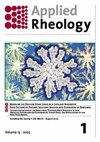Structural damage characteristics and mechanism of granite residual soil
IF 1.8
4区 工程技术
Q1 MECHANICS
引用次数: 0
Abstract
Deep and thick weathered granite crusts widely distributed in Xiangdong area, Hunan Province, due to their special structure, often induce geological disasters such as landslides under the conditions of excavation or atmospheric precipitation. In this article, using the direct shear test, X-ray diffraction test and scanning electron microscope test, the mechanical properties and the response mechanism of the microstructure of the granite residual soil in eastern Hunan area under different states were studied, and the structural damage mechanism of the granite residual soil was analysed. Based on the comprehensive structural potential, the theory characterizes its structure. The results show that the granite residual soil is mainly composed of minerals such as quartz, mica, kaolinite and feldspar, and it also contains a small amount of chlorite and calcite. The damage is mainly reflected in the attenuation of cohesion, while the change of the internal friction angle is small. The microscopic manifestation is the failure of the bridging structure between the aggregates, and the inter-granular pores are interconnected. The difference and shear strength response reflect the susceptibility to disturbance of granite residual soil and reflect that the structural strength has been damaged under the disturbance of human factors.花岗岩残积土的结构破坏特征和机理
湖南省湘东地区广泛分布的深厚风化花岗岩结壳,因其特殊的结构,在开挖或大气降水条件下,常诱发滑坡等地质灾害。本文利用直接剪切试验、X 射线衍射试验和扫描电镜试验,研究了湘东地区花岗岩残积土在不同状态下的力学性质和微观结构的响应机理,分析了花岗岩残积土的结构破坏机理。在综合结构势的基础上,对其结构进行了理论表征。结果表明,花岗岩残积土主要由石英、云母、高岭石、长石等矿物组成,还含有少量绿泥石和方解石。破坏主要表现为内聚力衰减,内摩擦角变化较小。微观表现为聚集体之间的桥接结构失效,粒间孔隙相互连通。差值和剪切强度反应反映了花岗岩残积土易受扰动的特点,也反映了结构强度在人为因素的扰动下已受到破坏。
本文章由计算机程序翻译,如有差异,请以英文原文为准。
求助全文
约1分钟内获得全文
求助全文
来源期刊

Applied Rheology
物理-力学
CiteScore
3.00
自引率
5.60%
发文量
7
审稿时长
>12 weeks
期刊介绍:
Applied Rheology is a peer-reviewed, open access, electronic journal devoted to the publication in the field of applied rheology. The journal provides the readers with free, instant, and permanent access to all content worldwide; and the authors with extensive promotion of published articles, long-time preservation, language-correction services, no space constraints and immediate publication.
 求助内容:
求助内容: 应助结果提醒方式:
应助结果提醒方式:


